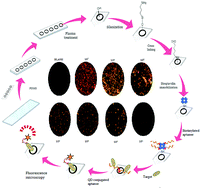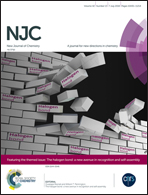A fluorescent dual aptasensor for the rapid and sensitive onsite detection of E. coli O157:H7 and its validation in various food matrices
Abstract
The speedy analysis of food products remains a keen area of concern; thus, rapid, highly efficient and robust on-site detection platforms are essential. Globally, Escherichia coli O157:H7 is the most common organism associated with food borne illness. The present study focuses on the development of a rapid onsite E. coli O157:H7 detection platform. Accordingly, target specific ssDNA aptamers are generated using whole cell-SELEX, where the highly reactive aptamers (EcoR1 and EcoR2) with the lowest dissociation constants (Kd) are further biotin tagged (EcoR1) and fluorescent labelled (EcoR2). Subsequently, the biotin-labelled aptamers are immobilized onto silane-glutaraldehyde-functionalized glass slides, which act as capturing ligands, and the QD-labelled aptamers act as revealing probes. The detection limit of the platform is found to be 102 CFU mL−1 within 15 min, and no cross-reactivity towards other related pathogens is observed. The developed assay is further evaluated in complex food matrices to determine the presence of E. coli O157:H7, where the results are found to be consistent with those of the conventional methods with a recovery percentage ranging from 76% to 91%. In conclusion, the developed method is promising for application in real-time food sample monitoring.



 Please wait while we load your content...
Please wait while we load your content...